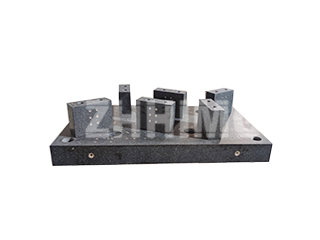The False Economy of Material Substitution
In the world of precision manufacturing, the quest for cost-effective solutions is constant. For small-scale inspection benches or localized testing stations, a question frequently arises: Can a modern Polymer (Plastic) Precision Platform realistically substitute for a traditional Granite Precision Platform, and will its accuracy meet demanding metrology standards?
At ZHHIMG®, we specialize in ultra-precision foundations and understand the engineering trade-offs. While polymer materials offer undeniable advantages in weight and cost, our analysis concludes that for any application requiring certified, long-term dimensional stability or nanometer flatness, plastic cannot replace high-density granite.
Core Stability: Where Polymer Fails the Precision Test
The difference between granite and polymer is not merely one of density or appearance; it lies in fundamental physical properties that are non-negotiable for metrology-grade accuracy:
- Thermal Expansion (CTE): This is the single greatest weakness of polymer materials. Plastics have a Coefficient of Thermal Expansion (CTE) often ten times higher than that of granite. Even minor fluctuations in room temperature, which are common outside of military-grade cleanrooms, cause significant, immediate dimensional changes in plastic. For example, ZHHIMG® Black Granite maintains exceptional stability, whereas a plastic platform will constantly “breathe” with temperature shifts, making certified sub-micron or nanometer measurements unreliable.
- Long-Term Creep (Aging): Unlike granite, which achieves stress stability through a months-long natural aging process, polymers are inherently viscoelastic. They exhibit significant creep, meaning they slowly and permanently deform under sustained loads (even the weight of an optical sensor or a fixture). This permanent deformation compromises the initial certified flatness over weeks or months of use, necessitating frequent and expensive re-calibration.
- Vibration Damping: While some engineered plastics offer good damping properties, they generally lack the massive inertial stability and high internal friction of high-density granite. For dynamic measurements or testing near vibration sources, the sheer mass of granite provides superior vibration absorption and a quieter reference plane.
Small Size, Big Requirements
The argument that a “small size” platform is less susceptible to these issues is fundamentally flawed. In small-scale inspection, the relative precision requirement is often higher. A smaller inspection stage may be dedicated to microchip inspection or ultra-fine optics, where the tolerance band is extremely tight.
If a 300mm×300mm platform is required to maintain ±1 micron flatness, the material must possess the lowest possible CTE and creep rate. This is precisely why Precision Granite remains the definitive choice, regardless of the size.
The ZHHIMG® Verdict: Choose Proven Stability
For low-precision tasks (e.g., basic assembly or rough mechanical testing), polymer platforms may offer a temporary, cost-effective substitute.
However, for any application where:
- ASME or DIN standards must be met.
- The tolerance is below 5 microns.
- Long-term dimensional stability is non-negotiable (e.g., machine vision, CMM staging, optical testing).
…the investment in a ZHHIMG® Black Granite platform is an investment in guaranteed, traceable accuracy. We advocate for engineers to select materials based on stability and reliability, not just initial cost savings. Our Quad-Certified manufacturing process ensures you receive the most stable foundation available globally.
Post time: Oct-13-2025

